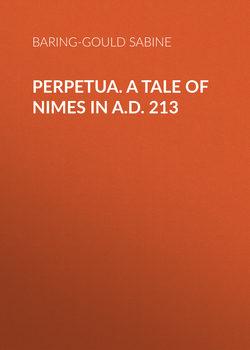Читать книгу Perpetua. A Tale of Nimes in A.D. 213 - Baring-Gould Sabine, Baring-Gould Sabine - Страница 7
CHAPTER VII
OBLATIONS
ОглавлениеThe house into which the widow lady and her daughter entered was that used by the Christians of Nemausus as their church. A passage led into the atrium, a quadrangular court in the midst of the house into which most of the rooms opened, and in the center of which was a small basin of water. On the marble breasting of this tank stood, in a heathen household, the altar to the lares et penates, the tutelary gods of the dwelling. This court was open above for the admission of light and air, and to allow the smoke to escape. Originally this had been the central chamber of the Roman house, but eventually it became a court. It was the focus of family life, and the altar in it represented the primitive family hearth in times before civilization had developed the house out of the cabin.
Whoever entered a pagan household was expected, as token of respect, to strew a few grains of incense on the ever-burning hearth, or to dip his fingers in the water basin and flip a few drops over the images. But in a Christian household no such altar and images of gods were to be found. A Christian gave great offense by refusing to comply with the generally received customs, and his disregard on this point of etiquette was held to be as indicative of boorishness and lack of graceful courtesy, as would be the conduct nowadays of a man who walked into a drawing-room wearing his hat.
Immediately opposite the entrance into the atrium, on the further side of the tank, and beyond the altar to the lares et penates, elevated above the floor of the court by two or three white-marble steps, was a semicircular chamber, with elaborate mosaic floor, and the walls richly painted. This was the tablinum. The paintings represented scenes from heathen mythology in such houses as belonged to pagans, but in the dwelling of Baudillas, the deacon, the pictures that had originally decorated it had been plastered over, and upon this coating green vines had been somewhat rudely drawn, with birds of various descriptions playing among the foliage and pecking at the grapes.
Around the wall were seats; and here, in a pagan house, the master received his guests. His seat was at the extremity of the apse, and was of white marble. When such a house was employed for Christian worship, the clergy occupied the seat against the wall and the bishop that of the master in the center. In the chord of the apse above the steps stood the altar, now no longer smoking nor dedicated to the Lar pater, but devoted to Him who is the Father of Spirits. But this altar was in itself different wholly from that which had stood by the water tank. Instead of being a block of marble, with a hearth on top, it consisted of a table on three, sometimes four, bronze legs, the slab sometimes of stone, more generally of wood.1
The tablinum was shut off from the hall or court, except when used for the reception of guests, by rich curtains running on rings upon a rod. These curtains were drawn back or forward during the celebration of the liturgy, and this has continued to form a portion of the furniture of an Oriental church, whether Greek, Armenian, or Syrian.
In like manner the tablinum, with its conch-shape termination, gave the type to the absidal chancel, so general everywhere except in England.
On the right side of the court was the triclinium or dining-room, and this was employed by the early Christians for their love-feasts.
Owing to the protection extended by law to the colleges or clubs, the Christians sought to screen themselves from persecution by representing themselves as forming one of these clubs, and affecting their usages. Even on their tombstones they so designated themselves, “Cultores Dei,” and they were able to carry on their worship under the appearance of frequenting guild meetings. One of the notable features of such secular or semi-religious societies was the convivial supper for the members, attended by all. The Church adopted this supper, called it Agape, but of course gave to it a special signification. It was made to be a symbol of that unity among Christians which was supposed to exist between all members. The supper was also a convenient means whereby the rich could contribute to the necessities of the poor, and was regarded as a fulfilment of the Lord’s command: “When thou makest a feast, call the poor, the maimed, the lame, the blind.”
Already, in the third century, the believers who belonged to the superior classes had withdrawn from them, and alleged as their excuse the command: “When thou makest a dinner or a supper, call not thy friends, nor thy brethren, neither thy kinsman, nor thy rich neighbors.” Their actual reason was, however, distaste for associating with such as belonged to the lower orders, and from being present at scenes that were not always edifying.
1
So represented in paintings in the Catacombs. There were two distinct types: the table in the Church and the tomb at the Sepulcher of the Martyr.
